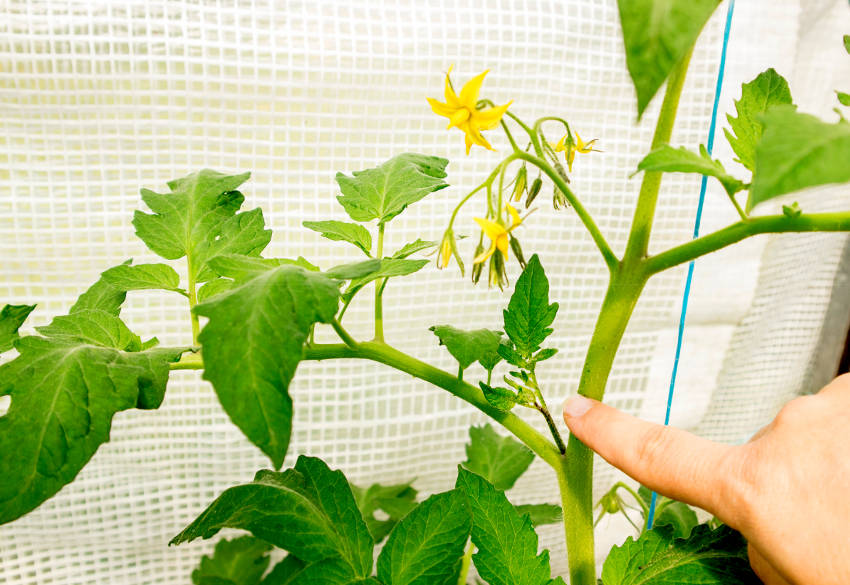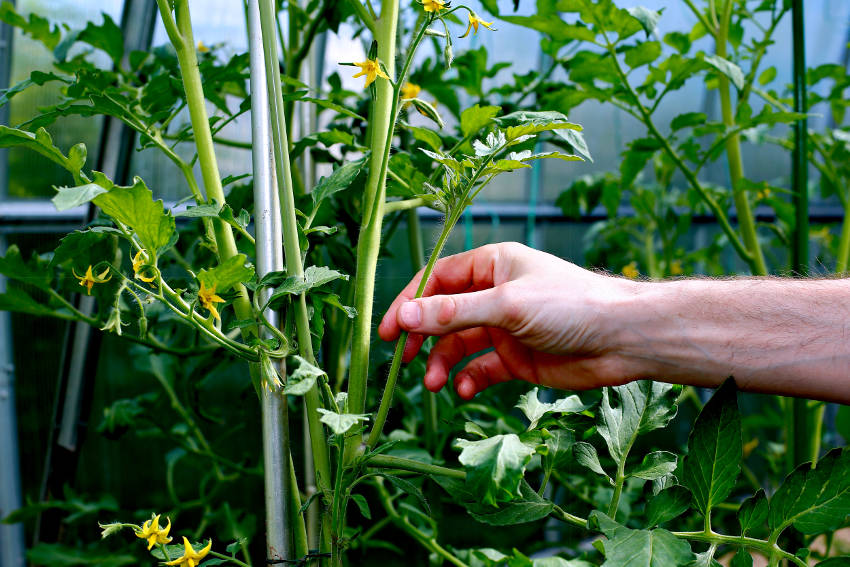Among all the popular crops a gardener can grow, it's perhaps tomatoes that have the most lore, myth, and mystery associated with them.
Pruning, in particular, is often portrayed as a dark art, with dire consequences for your crop if you get it wrong.
But it's really not as complicated as it sometimes seems. And increasingly, veggie gardeners are deciding it might not even be necessary in all cases.
What's the Theory Behind Pruning Tomatoes?
Tomato plants come in two main types, known as determinate and indeterminate. Straight away, it's clear why some people find the whole subject of tomatoes so intimidating. What's wrong with the more straightforward names of bush or climbing tomato?
Nonetheless, conventional wisdom says that indeterminate(climbing) types need pruning if you want to grow a respectable crop. Why is this?
Two Different Growing Habits
Determinate (bush) varieties of tomato have a preferred number of stems and fruit which they'll produce so long as conditions allow. Once they've achieved their predestined size and fruiting level, they'll stop growing.
There's no need to systematically prune these types of tomato plant. All it'll achieve is to reduce yields and increase the risk of disease.
In contrast, indeterminate (climbing) tomatoes will keep growing so long as they're alive. They'll continue to produce new side stems, new foliage, and new fruit for as long as they can.
This means that left to their own devices, indeterminate tomatoes will behave much like pumpkins. They'll collapse under their own weight, sprawling their way across your vegetable patch, eventually forming an impenetrable mess of vines, leaves, and hidden fruit.
Clearly, this isn't ideal. The traditional solution is to heavily prune the plants to keep them under control, and support what's left with stakes to keep them upright.
This is done by removing the young side stems, known as suckers, which sprout from the joints of the main stem and the fruit-bearing branches. This concentrates growth where it's most important for plant strength and fruit yield, in theory producing larger, healthier tomatoes.
But does this conventional wisdom always hold true? Is pruning always really necessary?
Opinion is divided. But apart from the fruit yield issue, there are several undisputed advantages to pruning.
Good Reasons to Prune Tomatoes
- Pruned plants are easier to manage, leaving one or two central stems which can be supported by a single stake.
- With less of the plant in contact with the earth, there's a lower risk of infection from soil-borne pathogens.
- With less energy devoted to leaf growth, the fruits arrive earlier and grow larger.
- The resulting tomatoes are easier to harvest, instead of being hidden behind masses of foliage.
- The open growth increases air flow between the leaves, reducing damp and fungal problems.
- Open plants also make it easier to deal with pests.
- Pruned tomato vines look neater and take up less space per plant.
Reasons Not to Prune
So far, pruning indeterminate tomatoes seems like a winning strategy. However, there are some definite drawbacks to bear in mind.
- Pruned vines necessarily have less foliage. This means there's less opportunity for photosynthesis, and so potentially less energy available to the plant for strong and healthy growth.
- Excessive or clumsy pruning can harm the plants, risking disease or infection.
- Pruning tends to produce smaller numbers of larger fruits. Of course, you may be happy with larger numbers of smaller fruits, making pruning counterproductive.
- It’s extra work. Once you start pruning you're committed to it for the length of the season. Suckers which develop late will produce poor-quality fruits while using up precious growing resources. It's sometimes better to let a larger number of early suckers get a head start, so they'll crowd out the latecomers.
There are good arguments for and against. But if you do decide to prune, here's what to do for maximum success.
Tips for Pruning a Single Stemmed Tomato Plant
For both determinate and indeterminate varieties, it's a good idea to remove any side stems that are low to the ground. These lower stems rarely fruit successfully and, and just drain energy from more productive parts of the plant.
From then on, for indeterminate (climbing) varieties, look for the young suckers sprouting from where the side stems meet the central stem. If you've never pruned tomatoes before, it can be hard to know exactly what to look for.
There's a simple, if slightly colourful, way of visualising the suckers. Imagine someone standing on their head, with their arms pointing upwards and outwards from their body at 45 degrees. Their arms represent the fruiting vines, while the suckers would be shoots sprouting from their armpits. These are what are removed.
For tender young suckers, simply pinch them out using your thumb and finger. This offers less risk of disease or infection compared to a clean knife cut, while also preventing regrowth.
For larger, thicker stems, a sharp blade or secateurs will be needed. In these cases, some gardeners like to prune a little distance away from the stem, leaving a leaf or two intact. This has two advantages.
Firstly, it leaves a couple of energy-producing leaves behind to soak up the sunlight. Secondly, if the cut becomes infected, there's a chance to remove it before the problem spreads to the main vine.
However, be aware that doing this can increase the overall pruning workload. The growth you leave behind will continue to sprout new suckers which need to be dealt with.
Lastly, whether you regularly prune or not, it's a good idea to give your tomato plants a late pruning a few weeks before the end of the growing season. This is especially true if you're facing a race to ripen the fruits.
Pinching out all the upward and outward growth concentrates the plant's sugars into the remaining fruits, helping them to ripen before the season's end.
Want Two or More Stems?
If you want more than one stem all you need to do is select the suckers you want to keep and leave them be. They will increase in size and ultimately turn into a new stem. How many stems to keep is really up to you and depends on your circumstances.
One of the most popular methods though is to prune the tomato plant to two stems. The sucker that forms immediately below the first set of flowers is the best one to keep as this is usually the most vigorous.
To Prune or Not to Prune?
Pruning has its purposes, but it's not something to do simply because every gardening book or website says so. If you want fewer but larger fruits, try it and see - you'll soon discover whether the results are worth the effort.
Likewise, if your tomatoes are plagued by fungal or damp problems, then heavy pruning is a sensible solution to attempt.
And lastly, if you want a neater, more compact tomato patch, you could either prune indeterminate varieties, or avoid the effort entirely by growing bush varieties.
But don't prune as a knee-jerk reaction, just because you feel you should. They're your tomatoes, it's your garden, and it's your choice.
Below: Small sucker that can be pinched out.

Below: Larger sucker that would need to be cut.






